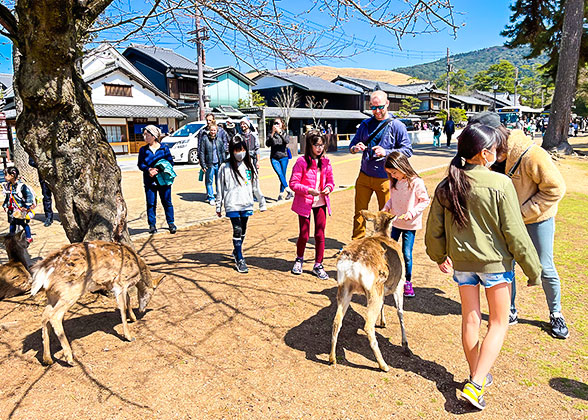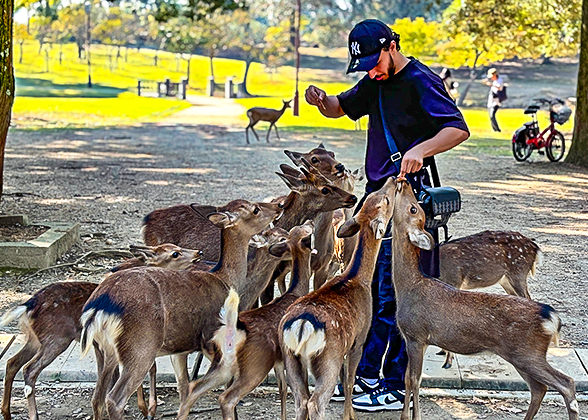Nara Park
Nara Park is located in the east of Nara city, and nearly 1,300 wild deer roam freely here. The park also preserves many historical and cultural relics and remains such as Todaiji Temple, Kasuga Taisha Shrine, Nara National Museum, and Kofukuji Temple. Besides, the beautiful natural landscape of Nara Park also attracts many tourists, likely cherry blossoms in spring and red maple leaves in autumn.Read More: Top 10 Unmissable Places to Visit in Japan
The Best Place to Interact with Wild Deer
Deer is called Messenger of God by the Japanese, and they are all over Nara Park. Even though they are wild, they are not afraid of humans. You can easily take photos with cute deer. If you want to be surrounded by deer, taking deer crackers in hand is the best way. The deer even can bow to you. Each portion of deer cracker costs about 200-300 yen.1. Don't play tricks on the deer, because they may attack you.
2. During spring, the deer is in heat, so please be careful when feeding them.
3. If you have food in hand, please eat it as soon as possible, otherwise the deer may rob you of food.
4. Deer cracker is the only allowed deer’s food, please do not throw other food to them at will.
5. The majority of deer are full in the afternoon, and some deer will return to the forest. Thus, you can feed them in the morning.
|
|
|
Best Time to Appreciate Beautiful Natural Scenery in Nara Park
Nara Park hosts nearly 1,700 cherry trees with different species. You can appreciate the beautiful cherry blossoms in spring and view the red leaves in fall. You can take the big red leaves as a bookmark. Besides, the fur of deer is more beautiful in April and May.

Cherry Blossom in Nara Park
|
![]() Read More: 8 Most Beautiful Places in Japan
Read More: 8 Most Beautiful Places in Japan
What Others to See in Nara Park
1. Todaiji Temple
Todaiji Temple is a Buddhist temple and was established in 728, owning more than 60 subtemples in Japan. Todaiji Temple consists of the Great Buddha Hall, Nigatsu-do Hall, Nandai-mon Gate, and Hokke-do Hall. The Great Buddha Hall, 57 meters (187 feet) wide, 50 meters (164 feet) deep and 47 meters (154 feet) high, is the largest wooden building in the world. The biggest bronze Buddha statue, Rushana Daibutsu, is located here. Besides, Nigatsu-do Hall located in the east of the temple allows you to overlook the cityscape of Nara. There are two huge statues of Kongo Rikishi standing on the two sides of the Nandai-mon Gate.
|
|
|
2. Kasuga Taisha Shrine
As one of the "cultural properties of the ancient capital Nara", Kasuga Taisha Shrine was registered as a UNESCO World Heritage Site. Kasuga Taisha Shrine was established in 768 in order to pray for prosperity and it owns nearly 3,000 subshrines around Japan. There are four main halls up in a row, showing the Kasuga-zukuri architecture style. The most notable scene here is nearly 3,000 lanterns, such as bronze lanterns and stone lanterns. The Lantern Festival is held in early February and mid-August each year. Besides, Kasuga Taisha Shinen Manyo Botanical Garden owns about 300 species of plants. On May 5 and November 3, you also can appreciate diverse plants at Manyo Gagaku Festival.
|
|
|
3. Mountain Wakakusa
Mountain Wakakusa is about 342 meters (1,122 feet) above sea level. Climbing to the top of the mountain allows you to appreciate the landscape of Nara Park from a different angle. Compared with other sites in Nara Park, Mountain Wakakusa is relatively peaceful. Photography enthusiasts prefer to take photos here. On the fourth Saturday of every January, the Wakakusa Yamayaki Festival is held. It is an ancient ritual to burn grass. Besides, you can see the gorgeous fireworks on the day.
|
|
|
4. Nara National Museum

|
5. Kofukuji Temple
Kofukuji Temple was established in 710, and it owns four national treasure buildings, namely the Five-Storey Pagoda, Three-Story Pagoda, Eastern Golden Hall, and Northern Round Hall. Five-Storey Pagoda is the symbol of the temple, and it is the second-highest wooden pagoda in Japan, about 50 meters (164 feet) high. Five-Storey Pagoda was rebuilt five times and the present pagoda was built around 1426. Furthermore, both Eastern Golden Hall and Northern Round Hall are octagonal halls, and they are called the most beautiful octagonal halls in Japan. Besides, the Sarusawa Pond is located south of the temple, which is an artificial pool with a circumference of about 360 meters (1,181 feet). The reflection of the Five-Storey Pagoda on the pond attracts many photographers.
|
|
|
6. Isuien Garden
Isuien Garden shows the life of the upper classes in Japan from 1603 to 1916. The garden is divided into two parts. The front garden consists of a private residence and tea rooms. The back garden is a cloister garden, allowing people to stroll and talk. Besides, you can appreciate more than 2,000 collections in the interior art museum, such as porcelain, bronzes, and tea sets.
|
|
|
Himoro Shrine is dedicated to the ice god and holds an Ice Festival on May 1st every year. Visitors can sample a variety of shaved ice and ask for a fortune-telling paper.
|
|
|
Recommended Visit Time:
The inner attractions in Nara Park are abundant, and it is worth spending one day experiencing the cultural, historical, and natural landscape. You can have a rest in Yume-kaze Plaza.How to Get to Nara Park
1. You can take JR Nara Line, then get off at JR Nara station, and walk for about 20 minutes to Nara Park.2. You can take Kintetsu Nara Line, then get off at Kintetsu Nara station, and walk for about 5 minutes to Nara Park.
Nearby Attractions
1. Gangoji Temple is a Buddhist temple, and has a history of 1,300 years. It is one of the seven major temples in the Southern capital of Japan and was listed world cultural heritage. You can walk here from Nara Park, and the single walk takes about 20 minutes.2. Naramachi Koshinoie is a traditional machiya house in Nara and is located at the southwest business district of Nara Park. You can walk here from Nara Park, and the single walk takes about 22 minutes.
See more:
You May Like
-
 10 Days Private Tour of Tokyo - Mt. Fuji - Nagoya - Takayama - Shirakawa-go - Kanazawa - Kyoto - Nara - Hiroshima - Osaka from USD3809
10 Days Private Tour of Tokyo - Mt. Fuji - Nagoya - Takayama - Shirakawa-go - Kanazawa - Kyoto - Nara - Hiroshima - Osaka from USD3809 -
 7 Days Mini Group Tour to See Highlights in Japan: Tokyo - Mt. Fuji - Kyoto - Nara - Osaka from USD2155
7 Days Mini Group Tour to See Highlights in Japan: Tokyo - Mt. Fuji - Kyoto - Nara - Osaka from USD2155 -
 11 Days Mini Group Tour to Tokyo - Hakone (Mt. Fuji) - Kyoto - Nara - Osaka - Hiroshima - Kanazawa - Shirakawa-go - Takayama - Tokyo from USD3554
11 Days Mini Group Tour to Tokyo - Hakone (Mt. Fuji) - Kyoto - Nara - Osaka - Hiroshima - Kanazawa - Shirakawa-go - Takayama - Tokyo from USD3554



